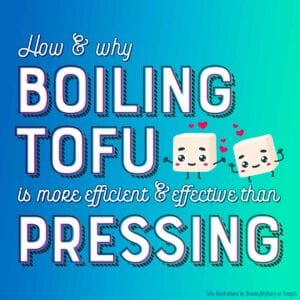This is also an updated version of a post originally penned in 2008, in which I clumsily tried to apply exactitude to a topic which is so vast it’s worthy of a multi volume encyclopaedia. This was updated in 2023. I want to preface this post by first saying I know there's no way to tackle a topic as big as tofu in a single blog post, so I mean this post as introduction to different tofu textures and coagulants used to make them. Nothing more.
I think it would be fair to guess most people know you can find tofu in both firm and soft varieties, but what's the meaning behind these differences? What's the difference between these products?
The different tofu textures and consistencies
You may have noticed packages of tofu labelled by firmness, ranging from extra-firm to soft and silken. This is a measure of density, where extra firm tofu contains more protein and less moisture than regular tofu or softer varieties. Soft tofu, in comparison, contains a lot more water and less protein.
Different textures are achieved predominantly by the amount of forced used to press liquid out of the blocks of curd, but coagulants also play a role.
Tofu coagulants
There are several coagulants that can be used in making tofu:
- Chlorides (nigari, bittern), including magnesium chloride, calcium chloride and straight up sea water (nigari is made by removing the salt from sea water). These are used to make regular and firmer styles of tofu. Nigari tofu is generally considered to have the best flavour, but this is really only relevant when the tofu is freshly made. The texture of tofu made with nigari may be more rustic in appearance.
- Sulphates, mostly gypsum (calcium sulphate), can be used to make a range of tofus ranging from firm to silken. Calcium sulphate produces a softer, glossier tofu than nigari and the yields are also higher.
- Glucona delta-lactone (GDL) is used in silken tofu production, where soy milk is coagulated directly in the container the tofu will be sold in.
- Home cooks might also use acidic ingredients like citrus juices or vinegar (not recommended due to lower yields) or epsom salts (magnesium sulfate).
Which coagulants were used prior to factories and commercial extraction measures relied mostly on geography. For instance China's inland mountains provided gypsum, which was used locally for that reason, whereas people closer to the sea would have been more likely to use nigari.
What about silken and other types of tofu?
Silken tofu is produced by coagulating a thick soy milk and it is a different process altogether. Regular and firm tofu are pressed in order to remove excess water, but silken tofu never goes through this process. Instead it is simply poured into a container and allowed to become firm on its own. This means the curds and whey don't get separated. Essentially silken tofu is so silky because it has a lot of water left inside.
Tofu most likely originates from China (the first recorded mention of tofu hails from a Chinese document in 965 CE, whereas the first mention in Japan was a couple hundred years later), and today a staggering variety of tofus are produced from within its borders. These include many varieties outside the boundary of coagulated blocks submerged tubs of water or found in the refrigerated sections of grocers.
Pressed tofu is an example. These ultra compacted blocks are made like regular tofu, except they are pressed under at least 60 PSI (60 pounds of pressure per square inch of tofu), but often more. Pressed tofu, which contains around 22% protein, is typically sold pre-seasoned in ambient packaging and can be used for snacking as is, in stir fries, as dumpling fillings, and more.
Tofu sheets are even more compacted, made by pressing tofu curds into thin sheets that resemble canvas. You’ll often come across preparations that call for cutting the sheets into noodle-like strips for use in salads. Tofu sheets are also used in stir fries, soups, and as a wrapper for other ingredients.
For a more in depth look at the variety of tofu in China alone, I recommend reading A Running List of China’s 20+ Tofus.
